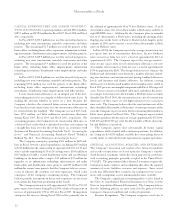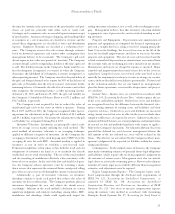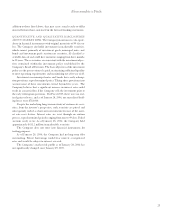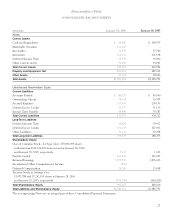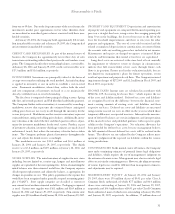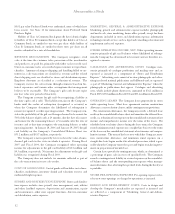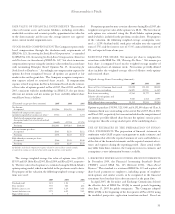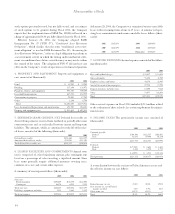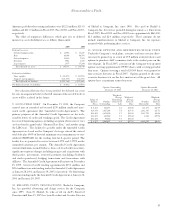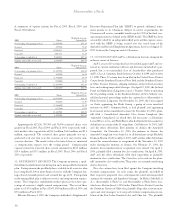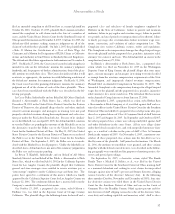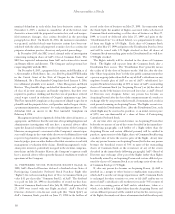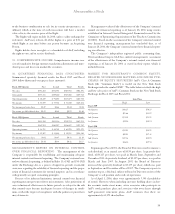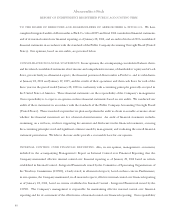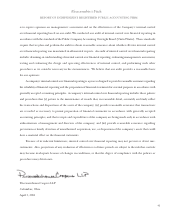Abercrombie & Fitch 2005 Annual Report Download - page 34
Download and view the complete annual report
Please find page 34 of the 2005 Abercrombie & Fitch annual report below. You can navigate through the pages in the report by either clicking on the pages listed below, or by using the keyword search tool below to find specific information within the annual report.
Abercrombie &Fitch
32
$0.01 par value Preferred Stock were authorized, none of which have
been issued. See Note 14 for information about Preferred Stock
Purchase Rights.
Holders of Class A Common Stock generally have identical rights
to holders of Class B Common Stock, except that holders of Class A
Common Stock are entitled to one vote per share while holders of
Class B Common Stock are entitled to three votes per share on all
matters submitted to a vote of shareholders.
REVENUE RECOGNITION The Company recognizes retail
sales at the time the customer takes possession of the merchandise
and purchases are paid for, primarily with either cash or credit card.
Direct-to-consumer sales are recorded upon customer receipt of mer-
chandise. Amounts relating to shipping and handling billed to cus-
tomers in a sale transaction are classified as revenue and the related
direct shipping costs are classified as stores and distribution expense.
Employee discounts are classified as a reduction of revenue. The
Company reserves for sales returns through estimates based on his-
torical experience and various other assumptions that management
believes to be reasonable. The Company’s gift cards do not expire
nor lose value over periods of inactivity.
The Company accounts for gift cards by recognizing a liability at
the time a gift card is sold. The liability remains on the Company’s
books until the earlier of redemption (recognized as revenue) or
when the Company determines the likelihood of redemption is
remote (recognized as other operating income). The Company con-
siders the probability of the gift card being redeemed to be remote for
50% of the balance of gift cards at 24 months after the date of issuance
and remote for the remaining balance at 36 months after the date of
issuance and at that time recognizes the remaining balance as other
operating income. At January 28, 2006 and January 29, 2005, the gift
card liability on the Company’s Consolidated Balance Sheet was
$53.2 million and $41.7 million, respectively.
The Company is not required by law to escheat the value of unre-
deemed gift cards to the states in which it operates. During Fiscal
2005 and Fiscal 2004, the Company recognized other operating
income for adjustments to the gift card liability of $2.4 million and
$4.3 million, respectively. No income for adjustments to the gift card
liability was recognized during Fiscal 2003.
The Company does not include tax amounts collected as part of
the sales transaction in its net sales results.
COST OF GOODS SOLD Cost of goods sold includes cost of mer-
chandise, markdowns, inventory shrink and valuation reserves and
outbound freight expenses.
STORES AND DISTRIBUTION EXPENSE Stores and distribu-
tion expense includes store payroll, store management, rent, utilities
and other landlord expenses, depreciation and amortization, repairs
and maintenance, other store support functions, direct-to-consumer
and distribution center expenses.
MARKETING, GENERAL & ADMINISTRATIVE EXPENSE
Marketing, general and administrative expense includes photography
and media ads, store marketing, home office payroll, except for those
departments included in stores and distribution expense, information
technology, outside services such as legal and consulting, relocation and
employment and travel expenses.
OTHER OPERATING INCOME, NET Other operating income
consists primarily of gift card balances whose likelihood of redemp-
tion the Company has determined to be remote and are therefore rec-
ognized as income.
CATALOGUE AND ADVERTISING COSTS Catalogue costs,
consist primarily of catalogue production and mailing costs and are
expensed as incurred as a component of “Stores and Distribution
Expense.” Advertising costs consist of in-store photographs and adver-
tising in selected national publications and billboards and are expensed
as part of “Marketing, General and Administrative Expense” when the
photographs or publications first appear. Catalogue and advertising
costs, which include photo shoot costs, amounted to $36.1 million in
Fiscal 2005, $33.8 million in Fiscal 2004 and $33.6 million in Fiscal 2003.
OPERATING LEASES The Company leases property for its stores
under operating leases. Most lease agreements contain construction
allowances, rent escalation clauses and/or contingent rent provisions.
For construction allowances, the Company records a deferred lease
credit on the consolidated balance sheet and amortizes the deferred lease
credit as a reduction of rent expense on the consolidated statement of net
income and comprehensive income over the terms of the leases. For
scheduled rent escalation clauses during the lease terms, the Company
records minimum rental expenses on a straight-line basis over the terms
of the leases on the consolidated statement of net income and compre-
hensive income. The term of the lease over which the Company amor-
tizes construction allowances and minimum rental expenses on a
straight-line basis begins on the date of initial possession, which is gen-
erally when the Company enters the space and begins to make improve-
ments in preparation of intended use.
Certain leases provide for contingent rents, which are determined as
a percentage of gross sales in excess of specified levels. The Company
records a contingent rent liability in accrued expenses on the consolidat-
ed balance sheets and the corresponding rent expense when manage-
ment determines that achieving the specified levels during the fiscal year
is probable.
STORE PRE-OPENING EXPENSES Pre-opening expenses relat-
ed to new store openings are charged to operations as incurred.
DESIGN AND DEVELOPMENT COSTS Costs to design and
develop the Company’s merchandise are expensed as incurred and
are reflected as a component of “Marketing, General and Admin-
istrative Expense.”


